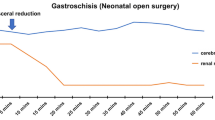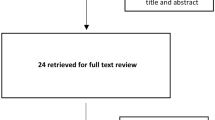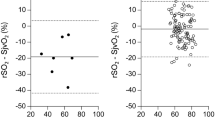Abstract
The maintenance of an adequate oxygen supply to tissues after congenital heart surgery is essential for good outcomes. The objective of this study was to assess the usefulness of near-infrared spectroscopy (NIRS) for estimating central venous oxygen saturation (ScvO2) using both cerebral and renal measurements, explore its relation with cardiac output measurements and check its ability to detect low cardiac output. A prospective observational pilot study was conducted in patients weighing <10 kg undergoing cardiopulmonary bypass surgery. Spectroscopy probes were placed on the forehead and renal area, and serial cardiac output measurements were obtained by femoral transpulmonary thermodilution over the first 24 h after surgery. In the 15 patients studied, ScvO2 was correlated with cerebral (r = 0.58), renal (r = 0.60) and combined (r = 0.71) measurements. Likewise, the systolic index was correlated with the NIRS signals: cerebral (r = 0.60), renal (r = 0.50) and combined (r = 0.66). Statistically significant differences were found in the NIRS measures registered in the 29 low cardiac output events detected by thermodilution: cerebral: 62 % (59–65) versus 69 % (63–76); renal: 83 % (70–89) versus 89 % (83–95); and combined 64 % (60–69) versus 72 % (67–76). In our series, combined cerebral and renal monitoring was correlated with central venous oxygen saturation and cardiac output; low cardiac output detection associated a different spectroscopy pattern.



Similar content being viewed by others
References
Austin EH, Edmonds H, Auden SM et al (1997) Benefit of neurophysiologic monitoring for pediatric cardiac surgery. J Thorac Cardiovasc Surg 114:707–717
Berens RJ, Stuth EA, Robertson FA et al (2006) NIRS monitoring during pediatric aortic coarctation repair. Pediatr Anesth 16:777–781
Bhalala US, Nishisaki A, McQueen D et al (2012) Change in regional (somatic) near-infrared spectroscopy is not a useful indicator of clinically detectable low cardiac output in children after surgery for congenital heart defects. Pediatr Crit Care Med 13:529–534
Bhutta AT, Ford JW, Parker JG et al (2007) Noninvasive cerebral oximeter as a surrogate for mixed venous saturation in children. Pediatr Cardiol 28:34–41
Dent CL (2006) Brain magnetic resonance imaging abnormalities after the Norwood procedure using regional cerebral perfusion. J Thorac Cardiovasc Surg 131:190–197
Di Nardo M, Cecchetti C, Stoppa F, Pirozzi N, Picardo S (2012) Abdominal compartment syndrome in childhood: the role of near infrared spectroscopy for the early detection of the organ dysfunction. Pediatr Surg Int 28:111–112
Egan JR, Festa M, Cole AD, Nunn GR, Gillis J, Winlaw DS (2005) Clinical assessment of cardiac performance in infants and children following cardiac surgery. Intensive Care Med 31:568–573
Gil-Anton J, Lopez-Bayon J, Lopez-Fernandez Y et al (2014) Cardiac index monitoring by femoral arterial thermodilution after cardiac surgery in children. J Crit Care 29:1132.e1–1132.e4
Hirsch JC, Charpie JR, Ohye RG, Gurney JG (2009) Near-infrared spectroscopy: what we know and what we need to know—a systematic review of the congenital heart disease literature. J Thorac Cardiovasc Surg 137:154–159
Hoffman GM, Stuth EA, Jaquiss RD et al (2004) Changes in cerebral and somatic oxygenation during stage 1 palliation of hypoplastic left heart syndrome using continuous regional cerebral perfusion. J Thorac Cardiovasc Surg 127:223–233
Hoffman GM, Mussatto KA, Brosig CL et al (2005) Systemic venous oxygen saturation after the Norwood procedure and childhood neurodevelopmental outcome. J Thorac Cardiovasc Surg 130:1094–1100
Hoffman GM, Ghanayem NS, Tweddell JS (2005) Noninvasive assessment of cardiac output. Semin Thorac Cardiovasc Surg: Pediatr Card Surg Ann 8:12–21
Johnson BA, Hoffman GM, Tweddell JS et al (2009) Near-infrared spectroscopy in neonates before palliation of hypoplastic left heart syndrome. Ann Thorac Surg 87:571–577
Kane JM, Steinhorn DM (2009) Lack of irrefutable validation does not negate clinical utility of near-infrared spectroscopy monitoring: learning to trust new technology. J Crit Care 24:472–477
Kurth CD, Steven JL, Montenegro LM et al (2001) Cerebral oxygen saturation before congenital heart surgery. Ann Thorac Surg 72:187–192
Kussman BD, Wypij D, Laussen PC et al (2010) Relationship of intraoperative cerebral oxygen saturation to neurodevelopmental outcome and brain magnetic resonance imaging at 1 year of age in infants undergoing biventricular repair. Circulation 122:245–254
López-Herce J, Fernández B, Urbano J et al (2011) Correlations between hemodynamic, oxygenation and tissue perfusion parameters during asphyxial cardiac arrest and resuscitation in a pediatric animal model. Resuscitation 82:755–759
Mc Quillen PS, Nishimoto MS, Bottrell CL et al (2007) Regional and central venous oxygen saturation monitoring following pediatric cardiac surgery : concordance and association with clinical variables. Pediatr Crit Care Med 8:154–160
McLuckie A, Murdoch IA, Marsh MJ et al (1996) A comparison of pulmonary and femoral artery thermodilution cardiac indices in paediatric intensive care patients. Acta Paediatr 85:336–338
Neshat Vahid S, Panisello JM (2014) The state of affairs of neurologic monitoring by near-infrared spectroscopy in pediatric cardiac critical care. Curr Opin Pediatr 26:299–303
Pauli C, Fakler U, Genz T et al (2002) Cardiac output determination in children: equivalence of the transpulmonary thermodilution method to the direct Fick principle. Intensive Care Med 28:947–952
Proulx F, Lemson J, Choker G, Tibby SM (2011) Hemodynamic monitoring by transpulmonary thermodilution and pulse contour analysis in critically ill children. Pediatr Crit Care Med 12:459–466
Rao R (2013) Is change in regional (somatic) near-infrared spectroscopy not a useful indictor of clinically detectable low cardiac output in children after surgery for congenital heart defects? Pediatr Crit Care Med 14:340–341
Tibby SM, Hatherill M, Marsh MJ, Murdoch IA (1997) Clinicians’ abilities to estimate cardiac index in ventilated children and infants. Arch Dis Child 77:516–518
Tibby SM, Hatherill M, Marsh MJ et al (1997) Clinical validation of cardiac output measurements using femoral artery thermodilution with direct Fick in ventilated children and infants. Intensive Care Med 23:987–991
Tume LN, Arnold P (2014) Near-infrared spectroscopy after high-risk congenital heart surgery in the paediatric intensive care unit. Cardiol Young 13:1–9
Tweddell JS, Ghanayem NS, Hoffman GM (2010) Pro: NIRS is “standard of care” for postoperative management. Semin Thorac Cardiovasc Surg Pediatr Card Surg Annu 13:44–50
Wessel DL (2001) Managing low cardiac output syndrome after congenital heart surgery. Crit Care Med 29:S220–S230
Zulueta JL, Vida VL, Perisinotto E, Pittarello D, Stellin G (2013) Role of intraoperative regional oxygen saturation using near infrared spectroscopy in the prediction of low output syndrome after pediatric heart surgery. J Card Surg 28:446–452
Author information
Authors and Affiliations
Corresponding author
Rights and permissions
About this article
Cite this article
Gil-Anton, J., Redondo, S., Garcia Urabayen, D. et al. Combined Cerebral and Renal Near-Infrared Spectroscopy After Congenital Heart Surgery. Pediatr Cardiol 36, 1173–1178 (2015). https://doi.org/10.1007/s00246-015-1139-z
Received:
Accepted:
Published:
Issue Date:
DOI: https://doi.org/10.1007/s00246-015-1139-z




